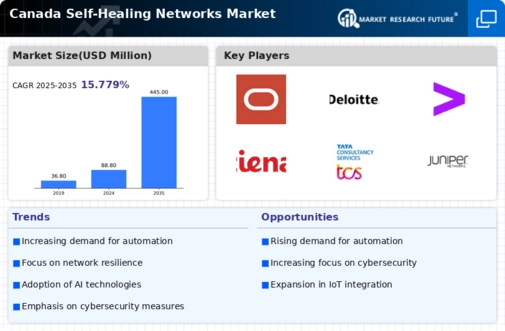Growing Adoption of Cloud Services
The rapid adoption of cloud services in Canada is reshaping the self healing-networks market landscape. As businesses migrate to cloud-based solutions, the complexity of managing these environments increases, necessitating the implementation of self healing networks. In 2025, it is estimated that over 60% of Canadian enterprises will utilize cloud services, creating a demand for networks that can self-manage and optimize performance. The self healing-networks market is thus poised to capitalize on this trend, as organizations seek to enhance their cloud infrastructure with resilient networking solutions.
Rising Demand for Network Reliability
The self healing-networks market in Canada is experiencing a notable surge in demand for enhanced network reliability. As businesses increasingly rely on uninterrupted connectivity, the need for self healing capabilities becomes paramount. This trend is driven by the growing complexity of network infrastructures, which often face disruptions due to various factors. In 2025, it is estimated that approximately 70% of Canadian enterprises prioritize network resilience, indicating a shift towards solutions that can autonomously detect and rectify issues. The self healing-networks market is thus positioned to benefit from this heightened focus on reliability, as organizations seek to minimize downtime and maintain operational efficiency.
Shift Towards Automation in Network Management
The self healing-networks market in Canada is witnessing a significant shift towards automation in network management. As organizations strive to improve operational efficiency, the integration of automated self healing capabilities becomes increasingly attractive. In 2025, it is anticipated that 50% of Canadian companies will implement automated network solutions, driven by the need to reduce manual intervention and enhance responsiveness. The self healing-networks market is likely to benefit from this trend, as automation not only streamlines operations but also enables networks to adapt dynamically to changing conditions.
Government Initiatives for Digital Infrastructure
Government initiatives aimed at bolstering digital infrastructure in Canada are significantly influencing the self healing-networks market. With investments exceeding $1 billion in 2025, the Canadian government is promoting advanced networking technologies to enhance connectivity across urban and rural areas. These initiatives are designed to support the deployment of self healing networks, which can adapt to changing conditions and ensure consistent service delivery. The self healing-networks market stands to gain from these public sector investments, as they create a conducive environment for innovation and the adoption of cutting-edge technologies.
Increased Cyber Threats and Network Vulnerabilities
The escalating frequency of cyber threats is a critical driver for the self healing-networks market in Canada. Organizations are increasingly aware of the vulnerabilities within their networks, prompting a shift towards self healing solutions that can autonomously respond to security breaches. In 2025, it is projected that cyber incidents will cost Canadian businesses over $5 billion, underscoring the urgent need for robust network defenses. The self healing-networks market is likely to thrive as companies seek to implement proactive measures that not only detect but also mitigate potential threats in real-time.





















Leave a Comment